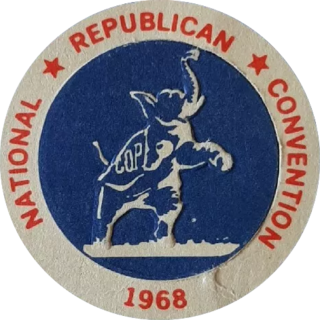Top Qs
Timeline
Chat
Perspective
1968 Republican National Convention
Political convention of the Republican Party From Wikipedia, the free encyclopedia
Remove ads
The 1968 Republican National Convention was held at the Miami Beach Convention Center in Miami Beach, Dade County, Florida, USA, from August 5 to August 8, 1968, to select the party's nominee in the general election. It nominated former Vice President Richard Nixon for president and Maryland Governor Spiro Agnew for vice president. It was the fourth time Nixon had been nominated on the Republican ticket as either its vice presidential (1952 and 1956) or presidential candidate (1960). Symbolic of the South's changing political affiliation, this was the first Republican National Convention held in a prior Confederate State.
This article needs additional citations for verification. (November 2015) |
Remove ads
Political context
Summarize
Perspective


Former Vice President Richard Nixon, emerged as the frontrunner again for the 1968 Republican presidential nomination. Nixon had been the Republican Party nominee in the 1960 presidential election, and lost to Democratic Party candidate John F. Kennedy.
The so-called "New Nixon" in the 1968 presidential election devised a "Southern strategy," taking advantage of the region's opposition to racial integration and other progressive/liberal policies of the Democratic Party and President Lyndon B. Johnson.
Nixon was nominated on the first ballot with 692 votes to 277 votes for Nelson Rockefeller, 182 votes for California Governor Ronald Reagan and the rest scattered. He was able to secure the nomination to the support of many Southern delegates, after he and his subordinates made concessions to Strom Thurmond and Harry Dent on civil rights, the Supreme Court, and the selection of a vice presidential candidate.[1]
Nixon decided not to re-select his 1960 running mate Henry Cabot Lodge Jr., and House Minority Leader Gerald Ford of Michigan proposed New York City Mayor John Lindsay for vice president. Nixon turned instead to another perceived moderate, Maryland Governor Spiro Agnew. Agnew, former Baltimore County Executive in the Baltimore City suburbs (1963–1967), and since Governor of Maryland, had come to Republican leaders and Nixon's attention when he summoned several Black civic, religious, and political leaders in Baltimore to the local State Office Building complex, following the disastrous April 1968 riots which enveloped Black sections of East and West Baltimore in the wake of the assassination of Martin Luther King Jr. in Memphis, Tennessee. Agnew complained of the Black leaders' lack of support after a number of what he perceived to be positive projects, programs and support by his Republican administration for the minority communities in the city. Agnew's biting comments caused many in the audience to walk out. Agnew was seen as a candidate who could appeal to Rockefeller Republicans, was acceptable to Southern Conservatives, and had a solid law-and-order record.[2]
In his acceptance speech, Nixon deplored the state of the union and urged a return to law and order both at home and abroad:
When the strongest nation in the world can be tied down for four years in Vietnam with no end in sight, when the richest nation in the world can't manage its own economy, when the nation with the greatest tradition of the rule of law is plagued by unprecedented racial violence, when the President of the United States cannot travel abroad or to any major city at home, then it's time for new leadership for the United States of America.[3]
Nixon also said that he had "a good teacher", referring to Eisenhower, and made the delegates happy with the statement "Let's win this one for Ike!" Eisenhower was not present during Nixon's speech nor during any part of the convention. Due to failing health, he was under doctor's orders not to travel, but addressed the convention by telephone. He died the following March.
Remove ads
Balloting
Summarize
Perspective
The following were placed into nomination:
Nominated for President
Nominated for Vice President
The Republican Convention Tally results
This was the last time during the 20th Century that two siblings (the Rockefeller brothers) received votes at a convention.
Results by state

Nixon Rockefeller Reagan Romney Various[a]



The balloting by state was as follows:[5][6][7]
Remove ads
See also
Notes
- Favorite sons received support from Ohio (Jim Rhodes), Hawaii (Hiram Fong), New Jersey (Clifford Case), Kansas (Frank Carlson), and Arkansas (Winthrop Rockefeller).
References
Bibliography
External links
Wikiwand - on
Seamless Wikipedia browsing. On steroids.
Remove ads












